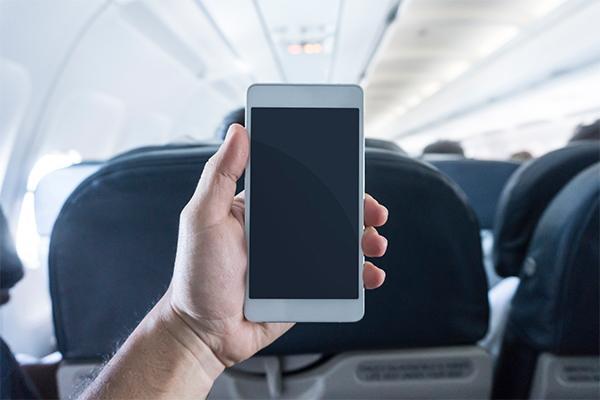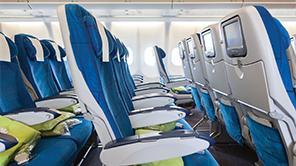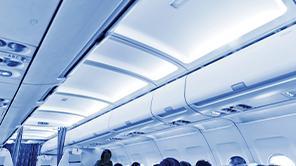Enhancing Aircraft Cabin Safety and Security with Electronic Access

Electronically operated locking mechanisms offer a streamlined and highly effective security solution that layers physical latching with electronic intelligence, which can be used to control and monitor access in aircraft cabin applications.
With the accessibility of lightweight composite materials and alloys, as well as new advances in technology such as smaller, lightweight laptops and tablets, traditional aircraft cabins are receiving a major facelift with regard to seating, lighting and interior paneling. Aircraft OEMs are also looking at ways to use these new technologies to improve aircraft cabin security and safety.
As OEMs concentrate on upgrading cabin interiors, engineers are beginning to investigate new technologies available, such as electronically driven locks and latches that can be networked into a plane’s control system to secure various interior applications. Incorporating these electronic access solutions into aircraft interiors can improve functionality and overall weight consumption, while also enhancing the safety and security of passengers and crew.
Why Electronic Access?
Electronic locks provide reliable, secure latching and many benefits over traditional mechanical systems, such as remote access and control. A complete solution, which includes an access control or input device, an electromechanical lock or latch and remote monitoring capabilities, can connect aircraft controls and interior security though a simplified, flexible platform.
Electronically actuated push-to-close latches offer a simple, versatile solution to achieve remote access within cabin interiors. The latch is mounted inside of a door or panel, requiring minimal interior space, and allowing a clean exterior surface where the latch is hidden from view. Southco combines its push-to-close latching solutions, such as the R4-EM Electronic Rotary Latch, with an electronic access controller to provide remote actuation. This gives OEM and Carriers the flexibility to tie into their existing controls or use a Southco engineered access control system.
These solutions provide intelligence not available with traditional lock and key mechanisms, in that electronic access can incorporate logic to control auxiliary functions such as lighting, alarms and audit trail data for tracking and monitoring access to restricted areas within the aircraft.
Southco’s Electronic Access Solutions can be networked into a plane’s control system to secure various interior applications:
- Allowing flight crew to control when passengers may access overhead luggage bins or lavatories
- Keeping access points secure during take-off, taxi and landing, or turbulence
- Providing space and power reduction capabilities to aid in operational footprint reduction
Safety and Security
Electronic access systems offer an added safety feature to secure various applications during takeoff, taxi and landing or when experiencing turbulence. Remote access provided by a networked electronic locking mechanism can allow the flight crew to control when passengers may access overhead luggage bins, lavatories or any other access point that could be overridden directly from the galley.
Southco’s line of Electronic Access Solutions layer physical access latching with electronic intelligence to provide enhanced access control of overhead bins.
The same reliable latching and control can be used to protect access to lifesaving devices such as life vests. For example, electronically driven latch points can be used to keep these items securely in place during routine flights until they must be deployed in the event of an emergency.
In contrast to mechanical lock and key systems, electronic access solutions provide better control and offer the convenience of on- and off-site monitoring. Should a security issue occur during aircraft operation, these systems can record the access activity for any networked enclosure. Captured in real time, these records or electronic “signatures” can be used to recreate a forensic record of date, time and duration of access.
For instance, electronic locks can be networked into the aircraft control system, notifying the pilot or security administrator that a panel has been tampered with. This provides an efficient solution for preventing physical security incidents from occurring on the ground or in the air.
Reduced Weight, Higher Performance
With lightweighting at the forefront of new aircraft designs, engineers are tasked with integrating lightweight materials into aircraft interior applications that provide enhanced functionality and promote fuel efficiency. This focus on overall efficiency in aircraft design extends to power consumption as well.
In addition to the reliable, secure latching and remote access control capabilities that electronic access solutions provide, they also offer space and power reduction capabilities that can help to reduce the overall operational footprint of an aircraft.
The gear motor-driven R4-EM for instance, applies a significant amount of force to an object at a relatively low speed to move heavier loads, which can be useful in applications where more force is needed, such as securing overhead storage bins during flight.
From a cost standpoint, gear motors offer more efficiency than solenoids, as power draw required by solenoid systems increases the cost of operation over time. Gear-driven electronic locks provide increased force at a fraction of the power draw, helping to reduce overall operating expenses per flight. Power saved by using the R4-EM provides the opportunity for smaller and lighter power generating equipment, and allows power to be refocused to other areas of the aircraft, such as lighting, motorized seating or galley applications.
Our plug & play DO-160 compliant filter is compatible with a wide selection of Southco's locking and latching solutions.
RTCA Compliance
Southco offers electronic access solutions that comply with requirements as defined by RTCA (Radio Technical Commission for Aeronautics):
- DO-160 Environmental Conditions and Test Procedures for Airborne Equipment – specifies test conditions for the design of avionics electronic hardware in airborne systems.
- DO-178B Software Considerations in Airborne Systems and Equipment Certification – determines if the software designed will perform reliably in an airborne environment.
Conclusion
As newer, smarter technologies and revolutionary lightweight materials are developed, design engineers must be prepared to incorporate these elements into OEM aircraft designs. Lightweight, efficient electronic access solutions provide enhanced security for a wide range of aircraft cabin applications, such as access paneling, storage bins, lavatories and galleys, offering many options for integration into aircraft control systems. Incorporating next generation electronic access control can help address the increasing need for physical security of access points whether in the air or on the ground, ultimately helping to improve the safety of passengers and crew.



